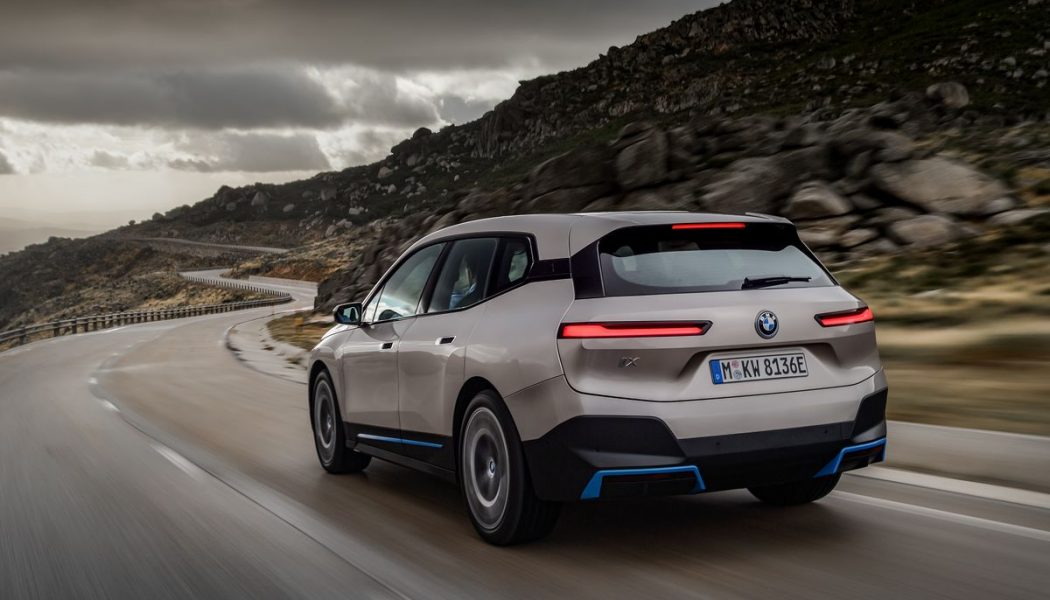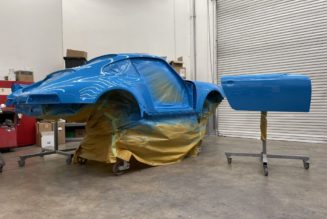BMW unveiled its next electric vehicle, the iX SUV, with 300 miles of range and gorgeous minimal interior. The iX is BMW’s technological flagship, meaning it incorporates multiple technologies that will be featured in the German automaker’s upcoming vehicles, mainly electric powertrain and driver interface.
The BMW iX will be the first vehicle to feature the automaker’s fifth-generation scalable EV technology, which means it can be adjusted to accommodate vehicles of different sizes and utility. The BMW iX will go into production at the company’s Dingolfing factory, located in Southern Bavaria, Germany, in the second half of 2021 and is scheduled to arrive on US shores in early 2022.
BMW didn’t reveal the size of the iX’s battery but says it will be capable of adding 75 miles for every 10 minutes of charge. The battery can be charged from 10 to 80 percent capacity in under 40 minutes and from zero to 100 percent in 11 hours at an 11kW Level 2 charging station.
BMW didn’t release a suggested price, but considering the similarities to the X5 SUV, which sells for the recommended price of $59,400, and the added costs of battery manufacturing, it seems highly likely that the iX could retail for $70,000 or more.
:no_upscale()/cdn.vox-cdn.com/uploads/chorus_asset/file/22028620/The_first_BMW_iX_On_Location_9.jpg)
:no_upscale()/cdn.vox-cdn.com/uploads/chorus_asset/file/22028619/The_first_BMW_iX_On_Location_3.jpg)
But perhaps most tellingly absent is any mention of autonomous driving capabilities. When it unveiled its precursor, the iNEXT concept, in 2019, BMW hinted that the vehicle would be outfitted with Level 3 autonomous driving. This means the car would perform 100 percent of the driving tasks under certain conditions, but that drivers would need to standby to take control when needed.
That feature seems to be missing from the iX SUV. “It is still too early to answer any pricing or specification questions,” a spokesperson said Wednesday. BMW makes no mention of autonomous driving capabilities in the videos or press materials announcing the vehicle’s launch. And it was probably a wise move, too, considering the legal and regulatory morass surrounding Level 3 driving. (More on that in a minute.)
The good thing about the specs that BMW is releasing, as long as they hold up, is that this is all coming from what BMW says is the fifth generation of its electric drivetrain (the battery pack, electric motor, and other technology that put the power to the road). BMW fans were disappointed that the automaker never made successors for the i3 or the i8 in the years since those cars were released. But the company is iterating on the underlying electric technology. Now, that fifth-generation tech will not only power the iX but also the i4 sedan (which shares a lot of the design features of the iX) and the China-made iX3 (which is now officially not destined for the US).
As an electric crossover SUV, the iX resembles the X5 but with a lower roofline and a more aerodynamic profile. BMW says it will have the roof height of an X6 and the wheel size of an X7. The design team wanted the exterior to look “clean and robust, monolithic almost, like a well rounded stone with some facets sheared off,” said Adrian van Hooydonk, BMW’s design director.
The iX was controversial when it was teased in concept form as the iNEXT in 2019, with its boxy, minivan shape and oddly shaped grille. The face of the vehicle features a unique take on BMW’s traditional kidney grille, sharing some of the aggressive characteristics of the company’s i4 concept sedan.
:no_upscale()/cdn.vox-cdn.com/uploads/chorus_asset/file/22028623/The_first_BMW_iX_On_Location_16.jpg)
:no_upscale()/cdn.vox-cdn.com/uploads/chorus_asset/file/22028621/The_first_BMW_iX_On_Location_15.jpg)
The interior of the iX appears to borrow from the Elon Musk playbook of minimalism but with a nod toward BMW’s roots as a luxury automaker. Van Hooydonk calls it a “loft on wheels.”
There is only one screen inside, which demonstrates remarkable restraint by BMW. (Most EVs are stuffed to the gills with multiple screens.) The curved, one-piece display serves as the locus for controlling all the vehicle’s functions. This involves bringing together the 12.3-inch instrument cluster and the central 14.9-inch infotainment screen to form a single unit angled toward the driver. The screen will feature BMW’s next-gen operating system that can be controlled with touch or voice activation.
The brain of this car will also be a significant improvement over past models, BMW says. The iX’s onboard computer will be able to “process 20 times the data volume of previous models,” the company says. As a result, “around double the amount of data from vehicle sensors can be processed than was previously possible allowing for more advanced future assist systems.”
BMW had intended for the vehicle to be capable of Level 3 freeway driving, but declined to explain why that feature was left on the cutting room floor. Level 3, as defined by the Society of Automotive Engineers, refers to highly automated driving where the driver still needs to be able to take over the vehicle upon request. Level 4 automation means that the car is capable of handing most driving situations itself, whereas Level 5 is largely theoretical and covers complete automation in any condition.
BMW has left the door ajar to future updates with higher levels of autonomous driving — though it was probably a wise decision to leave it out for now. Other automakers have been tripped up by the promise of Level 3 driving. Take Audi for example. The VW-owned automaker said its A8 sedan would come with a feature called Traffic Jam Pilot that, when active, would relieve human drivers of the need to pay attention during stop-and-go traffic. But the feature was contingent on approval from local authorities, and Traffic Jam Pilot remains dormant in most markets around the world. Audi has no plans to activate the feature, and Level 3 automation remains a morass of legal, regulatory, and business-related challenges.
:no_upscale()/cdn.vox-cdn.com/uploads/chorus_asset/file/22028658/BMW_iNEXT_INT_Sitzreihe_Fin.jpg)
:no_upscale()/cdn.vox-cdn.com/uploads/chorus_asset/file/22028657/BMW_iNEXT_INT_Mittelkonsole_01_Detail_1.jpg)
BMW has a raft of new EVs coming out in the next few years. The company is developing an all-electric version of its 5 Series and 7 Series sedans as well as its entry-level X1 SUV. Earlier this year, the company revealed the production iX3, the all-electric version of its top-selling X3 SUV. But the iX3 won’t be available in the US, only in Europe and China. When it comes out next year, the iX3 will pack a 74kWh battery pack, which should power the vehicle for up to 273 miles.
That means almost all of the German luxury automaker’s most popular cars will soon have all-electric variants. A fully electric version of the 3 Series, BMW’s most popular car in the US, has already been spotted in testing camouflage, and the forthcoming BMW i4 is expected to slot into the 4 Series lineup.
Half a decade ago, BMW was seen as being ahead of the curve when it came to electrification. But the company’s effort stalled out. That has left many BMW fans who were looking for a solid followup to the quirky i3 EV or the expensive-yet-head-turning i8 hybrid waiting impatiently at best. The iX is still a ways away from going into production, but based on the past year of exciting announcements coming out of Munich, the automaker appears well on its way to make up for lost time.










